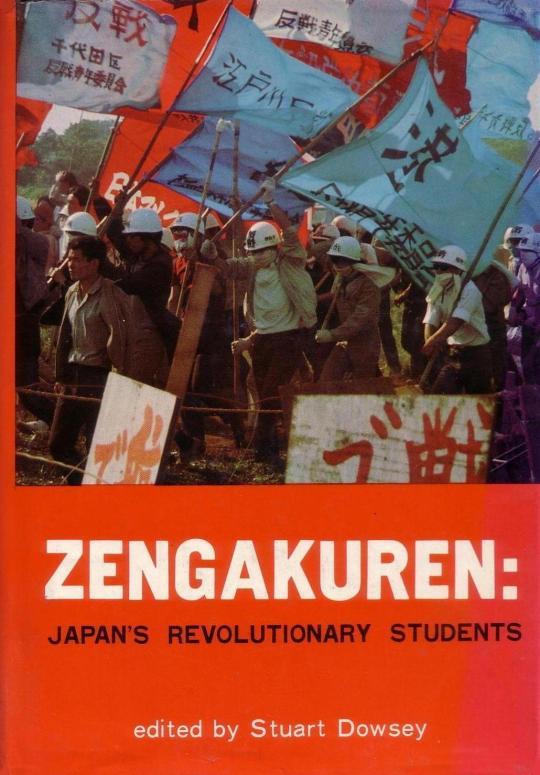#zengakuren
Text
1960-Michiko Kanba (樺美智子)
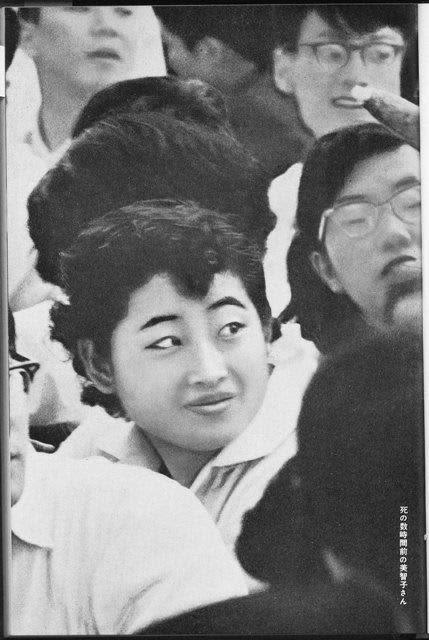
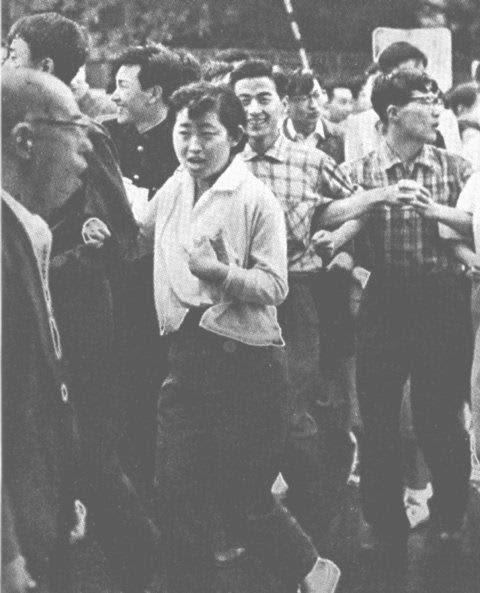

Michiko Kanba (樺 美智子, Kanba Michiko, November 8, 1937 – June 15, 1960) was a Japanese communist, University of Tokyo undergraduate, and a Zengakuren activist. She died in clashes between demonstrators and police at the South Gate of the National Diet Building in central Tokyo at the climax of the 1960 Anpo Protests against the US-Japan Security Treaty.
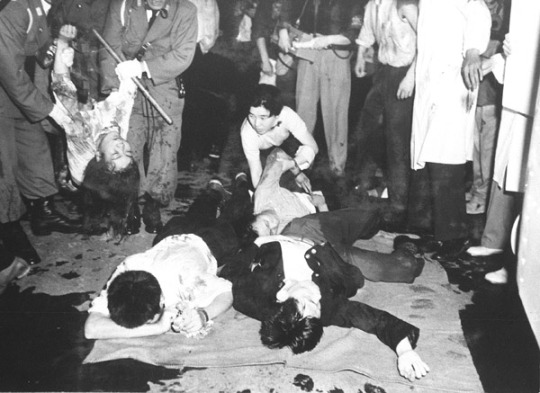
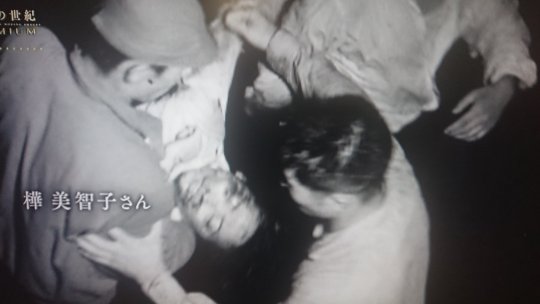
Kanba's death was widely covered at the time, and is seen as a symbol of the 1960 mass protests against the revised Treaty of Mutual Cooperation and Security Between the United States and Japan. Historian Nick Kapur argues that nationwide shock at Kanba's death helped force the resignation of Prime Minister Nobusuke Kishi and the cancellation of a planned visit to Japan by U.S. President Dwight D. Eisenhower.[8] Kapur says Kanba's death was viewed as a "triple tragedy," first because she was so young, second because she was a student at Japan's most elite university, and third, because she was a woman, at a time when it was still novel for women to participate on the front lines of street protests.

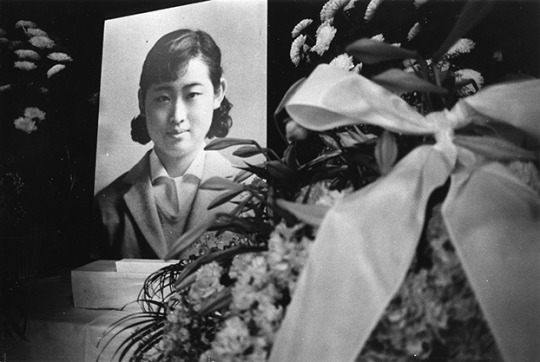

#Jun.15.1960#date of death#Michiko Kanba#樺美智子#University of Tokyo#Zengakuren#60年安保#Anpo protests#history today
2 notes
·
View notes
Note
Keelin, you watched Kamen Rider Black, right? You're the Showa Enjoyer. Is Black Sun ACTUALLY an interesting sendup to it in any way or is it just like, Edgy?
I hear it's very good but I can't bring myself to watch more bc I almost got sick watching episode 1.
I liked KR Black Sun. It can be quite heavy handed and certainly isn't hiding what it wants to say but I feel it managed to pull it off well. It's filled with references to Black but in its story it also goes beyond that and pays what also feels like a full blown homage to the 1971 Kamen Rider manga (specifically the manga for some things that occur) made by Ishinomori.
A LOT of this show digs deep into different civil rights movements and Japanese Imperialism and war crimes during World War 2 as well as policy upheld by former prime minister Shinzo Abe as well as his uncle and grandfather during their time in politics. It is impossible to separate politics from the show because it is a giant political piece.
If you're unfamiliar with any of the topics it touches on, here are some things to look into: Unit 731, Zainichi Koreans, Zengakuren movement, United Red Army.
If the gore is hard to watch or any brutality is making you sick I would suggest not watching it though because there's no point forcing yourself through a show that will make you feel bad. It's not mandatory to watch and the original Kamen Rider Black is far easier to watch for those who might be squeamish
41 notes
·
View notes
Note
I think for 2020!Keiko, it would be neat if she read about Japanese Revolutionary history, like the zengakuren.
She definitely would!
3 notes
·
View notes
Text
No Regrets for Our Youth
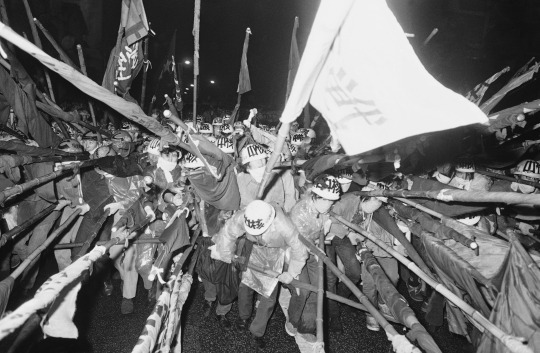
I thought this movie was excellent in some parts, and pretty boring in others.
I was really excited when I realized this was a movie about leftist student protests, because I find that subject pretty fascinating. After reading about the Anpo protests in Haruki Murakami's novels, I read quite a bit about Zengakuren, the coalition of student self-government organizations at the center of university protests both post and pre war. It was interesting to see a film depiction of one of the faculty removal incidents that came to define Zengakuren and their quest for academic freedom.
The opening scene in this movie is beautiful-- an almost comically idealistic portrayal of youth and freedom as Yukie and co. literally frolic in the fields, contrasted by an ominous burst of gunfire in the hills, which symbolizes the threat of militarism and facism for the group we are following.
Noge and Itokawa are fascinating characters. Like many young activists, they come to a point where they must choose to stand by their ideals and put their futures in jeopardy, or give them up and accept the promising careers their prestigious degrees promise. Kitokawa is able to accept the economic consequences of his ideals, but his mother ultimately persuades him to give them up and become a prosecutor. (Family is crucial for Kitokawa. Later he jokes that he only married for his mother's sake). Noge, of course chooses the latter path.
My beef with this movie is that, instead of focusing on these two characters, it focuses on Yukie. I understand that Yukie's romantic choice of Noge is intended to reflect the attraction of idealism and danger, but still. Call me sexist, but she's kind of boring compared to the other characters. I would rather see Noge engage in slick covert operations than watch Yukie give him a big hug when he gets home. Respect to Yukie, she goes hard in the rice fields, and I think she certainly comes into her own by the end of the movie, developing her own political passions. But the section in the country is basically just a farming montage, and it didn't keep me engaged.
Maybe I'm just TikTok action movie brained, but I felt like this movie never game me the scenes I wanted. Like, show me some protests scenes. Why can't I watch the farmers come in and destroy Yukie's rice fields? Why do I have to see the aftermath? It seemed like Yukie's father in law having his stupor broken by the destroyed rice fields and crying out in rage is supposed to be a powerful moment, but I didn't really care about him, so it just sort of fell flat.
Still good tho.
2 notes
·
View notes
Text

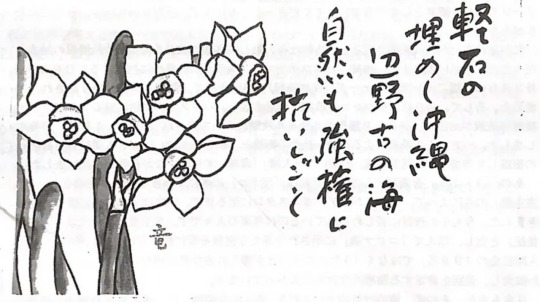
This article is part of The Funambulist 41 (May-June 2022). On May 28, 2022, Fusako Shigenobu will be free from the Japanese prison where she was forced to spent the last 21.5 years. We wanted to celebrate her commitment to the liberation of Palestine in our current issue by commissioning a piece to her daughter, May Shigenobu. For the occasion, we placed May’s text in open access. You may order the issue if you’d like to have it on paper.
One month before the release of Fusako Shigenobu after she spent the last 21.5 years in a Japanese prison, we asked May Shigenobu to draw a political portrait of her mother as an homage to the incarnate example of internationalist solidarity. She describes Fusako’s early year of activism leading her to take high responsibilities in the Japanese Red Army before relocating to Beirut in order to play an active role in the Palestinian liberation struggle.
The morning of November 8, 2000 was cold yet sunny. I was chatting with my friends at the university in Beirut, preparing to attend my first class of the day, when my phone rang. “Is your family okay?”, the caller—a familiar voice—asked in a coded manner. I was suddenly made aware that something had happened to someone in my secret Japanese community, my family. I was no longer focused on my friends› conversations, nor on my classes, no matter how hard I tried. Finally, I gave in to my anxiety and headed back home to see if I could glean any information about what happened from the news.
In the span of less than a month, while my mother was being detained and interrogated by the Japanese government, she wrote a 200-page report describing our clandestine life as mother and daughter, on the floor of her detention cell. Thanks to this, I finally obtained my Japanese citizenship after 27 years of living as an undocumented and stateless person. The report was later published as a book, entitled I Gave Birth to You Under an Apple Tree (2001). It was the first of several books she would publish from prison.
Fusako Shigenobu was born in Setagaya, Tokyo, on September 28, 1945, the same month Japan formally signed the surrender to U.S. armed forces at the end of World War II. Fusako’s childhood and early life in post-war Japan was nothing out of the ordinary. She was the third of four children born in a poverty-stricken Japan to educated and previously privileged parents. Her father had worked as a volunteer teacher in Buddhist temple schools after World War I, and was later conscripted to join the Japanese Imperial Army. There, he joined a group of nationalist officers in order to rebel against the political elite, who were profiting off Japan’s imperialist wars of expansion in Asia. For his participation in this group, he was punished and exiled to Manchuria, which was under Japanese colonial rule at the time. For much of her early life, Fusako was overshadowed by her nationalist activist father, and remained apolitical.
After graduating from high school Fusako began working at a multinational corporation called Kikkoman. This was an elite, white collar job that would have put her on a steady path toward lifetime employment and thus membership in Japan’s economic elite. However, her motivation for working at Kikkoman was primarily to put herself through college. After years of working evening shifts, she would eventually earn a dual degree in Political Economy and History.
The normalcy in her life stopped on her first day of attending Meiji University, when she joined a student sit-in protesting tuition hikes at the university, an issue that directly affected her as a working student. From that day on, she was awakened to the world of student activism by Zengakuren, a league of student associations that was initially concerned with campus issues, workers rights, and poverty, but later evolved to the radical New-Left activism of anti-Vietnam war, anti-AMPO security pact between Japan and the U.S., as well as anti-capitalism and global anti-imperialism. In 1969, Fusako joined the radical Red Army Faction (RAF) and rose up its ranks to finally become head of the International Relations Bureau.
In 1970, at a time when international attention was focused on the U.S. war in Vietnam, Fusako was introduced to an Arabist in Japan and started to learn about the Palestinian struggle against Israeli settler colonialism and occupation. This changed everything. From then on, she decided to dedicate her life to the Palestinian struggle. She forged bonds of solidarity with the Palestinians in Lebanon, calling on her fellow activists back in Japan to join in the act of solidarity in whatever field they were skilled at.
The Japanese Red Army (JRA) is mostly known in Japan and elsewhere for its armed struggle and military operations against capitalist and imperialist interests around the world, which often took the form of hijacks and hostage-taking. However, it is much lesser known that the JRA undertook consistent and effective solidarity with the Palestinian people through humanitarian, artistic, and grassroots efforts.

Fusako Shigenobu alongside Ghassan Kanafani at Al Hadaf magazine office where she worked in 1972.
Fusako had initially worked at Al Hadaf magazine, the public relations office of the Popular Front for the Liberation of Palestine (PFLP), alongside its editor-in-chief Ghassan Kanafani. Her role there strengthened Japanese support for the Palestinian cause by keeping Japanese leftist activists informed of what was happening on the ground in the Palestinian struggle and the Middle East. She also provided logistical support to Japanese volunteers who arrived, connecting them to related Palestinian partners.
Some Japanese medics went to Lebanon to open clinics in refugee camps, or to train people in acupuncture; artists contributed artwork or co-produced plays, while writers wrote about or translated the writings of prominent Palestinians such as Kanafani. For decades, the JRA performed the kind of work that NGOs have taken on. The only difference was its ideological framework and the fact that they were volunteers.
Fusako was forced into underground life shortly after the 1972 PFLP operation on Lydd airport in historic Palestine/Israel, because one of the three Japanese who took part in the attack was arrested. It became known to the Israeli settler government that Japanese activists were now taking part in the PFLP armed operations led by Wadie Haddad. As such, they became potential assassination targets for the Israeli State.
Fusako Shigenobu’s arrest warrant was issued by the Interpol, after one of the hostages at the French embassy in The Hague (another one of PFLP External Operations with Japanese volunteers in 1974) initially falsely identified her as amongst the hostage takers. This false testimony was later retracted but the Interpol warrant remained.
However, when she was arrested in Japan, Fusako was first charged with two counts of passport forgery. The prosecution then brought her “Hague operation involvement” to the forefront, to insure a longer jail term. Throughout her six-year court hearings (2001-2006), the prosecution could not present any concrete evidence, but instead based their accusations on statements taken from interrogations of former JRA members (of whom two witnesses stated on the stand that they were either coerced or blackmailed to sign).
My mother was sentenced to 20 years (but really spent 21.5 years in prison) for an operation she had no hand in directly or indirectly, even according to prosecutors› witnesses and others that came to testify such as Leila Khaled (who worked with Haddad at that time). The fact that there was no concrete evidence of her involvement in the event did not stop the judge from handing down “attempted manslaughter.” with the reasoning of possibility and likelihood of conspiring with Japanese commandos.
After attending most of the six years of court hearings and seeing extensive press presence in court, I observed very little content coverage in the media. When Fusako was accused of “possibly conspiring,” I realized that it was mostly a political prosecution masquerading as “democratic justice”.
The moment I emerged from hiding also marked the beginning of my journey with countering decades of state-sponsored propaganda about my mother, along with her revolutionary leftist organization, the Japanese Red Army, and their dedication to Palestine’s liberation.
Placed on a pedestal that requires me to condemn my own mother’s actions, my life’s work was determined the moment I disclosed my identity. Although millions around the world may believe the state-sponsored propaganda that labels her a “terrorist,” as her daughter, I know who Fusako Shigenobu really is.
I experienced firsthand the love and dedication she had not just for me, but for all people and especially those who are oppressed. I know her true motivations and what she sacrificed for, ideals that few cling to in a world that is driven too often by power, money, and greed. She taught me not only to be kind, or that all discrimination is unjust, but that we must work to end such injustices.
As a foreigner trying to express solidarity with another people, my mother has always told me that her life as a revolutionary and as a mother has been a constant learning curve. Ultimately, she found that ideology was not enough, and that family, love, camaraderie, and solidarity were equally important elements of a revolutionary struggle.
Love is a shared foundation… Our comrades are family.
(From I Decided to Give Birth to You Under the Apple Tree)
As a zealous political activist firmly backed by leftist anticolonial and anti-imperialist ideological background, my mother became someone who understands that revolution is not limited to an ideological framework, and that it has to be lived and practiced with others through inclusive life experiences.
As much as she might have changed, the world has also changed with how activism is practiced. Alliances have shifted, new grassroots movement tools have been created… The only constant between then and now is the Israeli settler colonisation of Palestine, its aggression and discrimination against the Palestinian people, and the need to fight against this injustice with all forms of solidarity.
She has only lived 26 years in Japan, half a century ago. It will be a lot to get used to, and much to catch up, along with many friends, places, and memories to revisit. Many of her friends and acquaintances have unfortunately passed away, and I do worry about her safety and the cruelty that she might face in Japanese society, where she is still perceived as a “terrorist.” However, I do look forward to the time, at long-last, I will have with her to explore together her homeland that she really loves. I anticipate that we will have many long hours of discussing politics as we used to, and engage in many informative humanitarian projects to continue our solidarity work to fight oppression, inequality, and injustice around the world. ■
1 note
·
View note
Photo

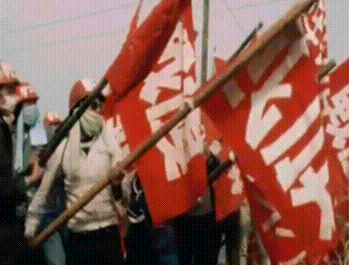
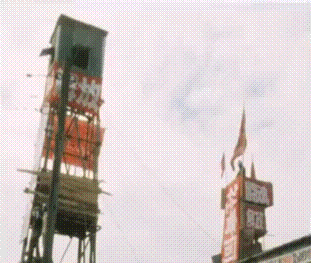


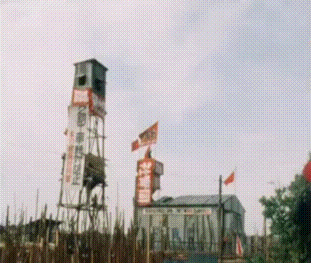
1971 - Left-wing students and farmers build fortresses on the construction site of Narita airport near Tokyo, and prepare to defend them from thousands of riot cops. [video]/[video]
#1971#narita airport#japan#airport#construction#development#red flag#black flag#communism#anarchism#blockade#fortress#gif#direct action#sanrizuka struggle#zengakuren
1K notes
·
View notes
Photo

Stefano Bellieni, Zengakuren Zenkyōtō. Giappone: rapporto su una generazione in rivolta, «Nuovi testi» 7, Feltrinelli, Milano, 1969
#graphic design#book#cover#book cover#stefano bellieni#zengakuren#zenkyōtō#nuovi testi#feltrinelli#1960s
26 notes
·
View notes
Photo

Zengakuren and police do battle outside the Diet (Parliament) Building in Tokyo during protests against pro-American Prime Minister Nobusuke Kishi on June 15, 1960.
111 notes
·
View notes
Text
#toshio matsumoto#funeral parade of roses#avant garde#funeral das rosas#cinema japonês#cinema#lgbtq#zero jigen#zero dimension#zengakuren#nanshoku#westernization#japão
1 note
·
View note
Text
1960-Anpo protests "June 15th Incident"


On June 15, as part of the anti-Treaty coalition's 24th united action, hundreds of thousands of protestors marched on the National Diet in Tokyo. In the late afternoon, the protestors were attacked by right-wing ultranationalist counter-protestors, who rammed them with trucks and attacked them with wooden staves spiked with nails, causing dozens of injuries from moderate to severe, including several hospitalizations.



Just a few minutes later, radical left-wing activists from the nationwide student federation Zengakuren smashed their way into the Diet compound itself, precipitating a long battle with police,[1] who beat the unarmed students bloody with their batons in front of mass media reporters and television cameras.[32] The police finally succeeded in clearing the Diet compound after 1 a.m., but in the struggle, a young female Tokyo University student and Zengakuren member named Michiko Kanba was killed.
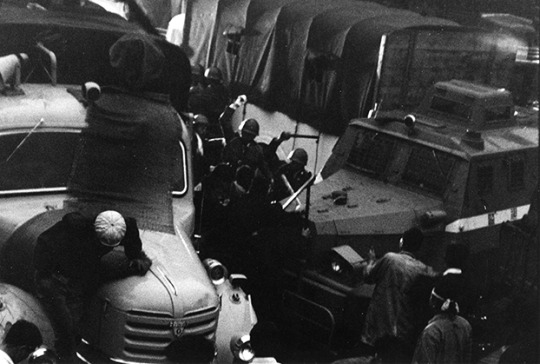



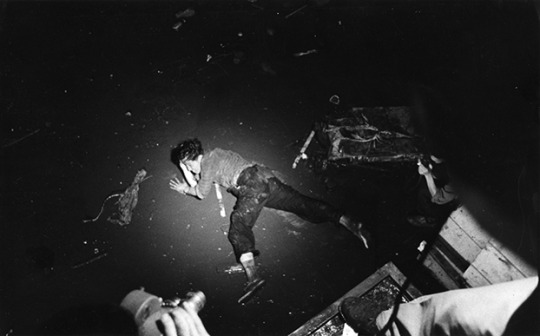

#Jun.15.1960#Anpo protests#June 15th Incident#安保闘争#Japanese Houses of Parliament#60年安保#history today
2 notes
·
View notes
Photo

Zengakuren students attacking riot police.
101 notes
·
View notes
Text
Cruel Story of Youth (ANPO HANTAI 😾🚨)

What a strange and beautiful movie this was. Looking at everyone else’s blog posts, it seems like there were mixed reactions to this film. I kinda get that— the acting wasn’t great, and the fight scenes were pretty dumb. Still, I thought this movie was a really fascinating exploration of 60’s counterculture. It was almost like a Murakami novel: Anpo, lots of casual sex, cigarettes, and music.
In terms of cinematography, this my favorite movie by far. Obviously I’m biased because of the color, (which is just beautiful) but I also loved the shaky shots. The motorcycle ride down to the ocean was amazing, and almost every scene just had such potent atmosphere. Kiyoshi’s dead eyes after sleeping with his mistress really struck me. Again, could just be the colors, but I love how the film was shot. I also enjoyed how the plot was structured, with all sorts of unexpected connections between the characters revealing themselves as the film goes on— the abortion clinic being owned by Yoko’s former lover, Horio knowing Kiyoshi’s mistress, etc. There were some neat reveals.
But most of all, the cultural commentary is fascinating. To me, this movie is fundamentally about two versions of rebellion.
One version is idealistic rebellion, which the film mostly associates with the youth of the post-war period. These youth fought for what they believed in, and championed democracy and ideals. But, through Yuki and her former lover, we see that many of them ultimately became disillusioned with their inability to change the system, and retreated back into the stability of the past, symbolized by Yuki’s lover.
This idealism, of course, has not died out by the 1960s— we still see dozens of the Zengakuren student protesters that symbolize it throughout this film, snake dancing through the streets in protest. But a new version of rebellion is becoming popular among the youth— a rebellion without a cause. A rebellion of hedonism and casual sex, one that discards entirely any sort of moral framework or ideology. Kiyoshi is this ideology personified. He rebels, but only because he wants to, not because he really cares about anything— including his lover Makoto. He is wary of dreams and ideals, believing that the world is too cruel to sustain them: “We have no dreams, that’s why we’ll never end up like you”, he tells Yuki.
I think a lot of what this film does is display the hypocrisy of this kind of rebellion through Kiyoshi’s actions. Kiyoshi hates women who sleep with older men, but he himself sleeps with an older mistress for money. He feels justified in robbing men who use women for their bodies, though he sexually assaults Makoto several times. He fights with pimps, though he himself is essentially pimping out his girlfriend through his robbery scheme. As the police officer in his interrogation points out, he is no better than the old men he hates so much. He is a corrupted youth— a sour green apple, in stark contrast to the Zengakuren red.
Anyway, I could ramble on— i’m pretty into the whole Anpo and counterculture thing (clearly), but basically what I’m saying is that this film is a critique of a lot of the counterculture ideologies that emerged during the 60s, and the danger of becoming just like the adults you despise when you discard your ideals.
1 note
·
View note
Link
4 notes
·
View notes
Photo







March 26 1978 - Four days before the new Narita airport near Tokyo was supposed to open, left-wing protesters against the project rammed through the gates of the airport, burned cars and battled police with iron bars and molotovs.
This attack was only a diversion however, allowing another group to infiltrate the airport’s control tower. They smashed all the equipment inside and occupied the tower for several hours, causing half a million dollars worth of damage and delaying the opening of the airport by another few months. [video]/[video]/[video]
#japan#narita airport#narita#direct action#resistance#zengakuren#sanrizuka#sanrizuka struggle#riot#riot police#police#acab#police brutality#gif#1978#environmentalism#development#airport#hammer and sickle#communism#police car#fire#flames#molotov#vandalism#tear gas#red flag
2K notes
·
View notes
